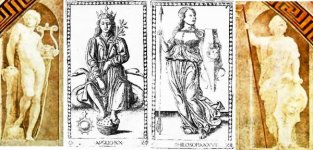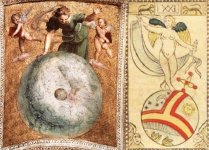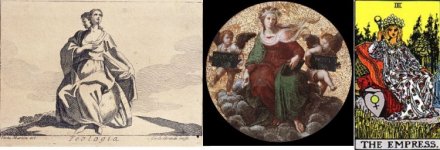DoctorArcanus
Tarot in Raphael's Stanza della Segnatura
It is not a large room: about 50 square meters. You enter through one of the two small doors in the slightly longer walls. The room is now empty: the books of Julius have disappeared. The floor is adorned by a mosaic of many colors, made in the style of the Norman and Arab mosaics you can see in Sicily. The walls and the ceiling are entirely covered with paintings by Raphael.
The School of Athens is right in front of you. The scene is crowded with tens of philosophers talking to each other, writing, thinking, walking. They inhabit a fantastic architecture, something that looks both like a catholic church and a classical temple. The walls are decorated by statues of the ancient gods. On Aristotle's side is Minerva, goddess of knowledge and war, with her shield and spear. Raphael has put himself on Minerva's side, at the border of the painting. On Plato's side, Apollo, the god of Poetry, naked and relaxed, holds his lyre.
The wall on your left presents a group of three women. You recognize the allegories of three Virtues: Strength (with the lion), Prudence (with the mirror) and Temperance (with the reins).
Two smaller paintings at the sides of the window represent Emperor Justinianus and Pope Gregory IX.
On the wall at your right side you meet Apollo again. He is playing is viola, triumphant, in the middle of the scene, on the top of Mount Parnassus. Around him the muses and the best poets of all times: Homer, Dante, Petrarch and many others.
In front of the School of Athens you see the Disputation of the Holy Sacrament: a complex vision in which the terrestrial and celestial champions of faith are gathered around the Eucharist. The division between high and low coexists with a division between left and right, representing active faith (Saint Girolamus, Beato Angelico) on the left and contemplative faith (Saint Bonavenura, Saint Thomas, Dante) on the right.
The ceiling presents four circular paintings and four rectangular paintings by Raphael. The circles represent the four faculties of the medieval universities: Theology, Poetry, Philosophy and Jurisprudence (Justice). The choice of the other four subjects aims at representing the interaction between the two principles in the circular paintings around each square: Apollo (for the third time) and Marsia, Astronomy (or maybe the "Primus Mobilis" / "First Mover"), Salomon's judgment, Adam and Eve.
What is the relation with Tarot?
The topic has already been touched a few times. I found this thread particularly rich of ideas:
http://www.tarotforum.net/showthread.php?t=34729&page=6&pp=10
In my opinion, a close analogy with the Mantegna Tarot is evident. Both series of images are “Cosmographs”: graphical representations of the universe. The Mantegna Tarot (see attachment) has two Apollos (the first is the king of the muses, the second is the Sun) and one Minerva (Philosophy). Much more could be said about the analogies between these two Cosmographs.
The Sola-Busca Tarot also presents Apollo (Apolino) and Minerva (Pallas), though still represented in a pre-classical, medieval style.
For more classical Tarot decks analogies are maybe less evident but some can still be found: the Virtues, of course; Adam and Eve as the Lovers; Jesus in the Dispute as the World (in particular, the Vieville deck version).
What do you think?
More ideas or associations?
Marco
It is not a large room: about 50 square meters. You enter through one of the two small doors in the slightly longer walls. The room is now empty: the books of Julius have disappeared. The floor is adorned by a mosaic of many colors, made in the style of the Norman and Arab mosaics you can see in Sicily. The walls and the ceiling are entirely covered with paintings by Raphael.
The School of Athens is right in front of you. The scene is crowded with tens of philosophers talking to each other, writing, thinking, walking. They inhabit a fantastic architecture, something that looks both like a catholic church and a classical temple. The walls are decorated by statues of the ancient gods. On Aristotle's side is Minerva, goddess of knowledge and war, with her shield and spear. Raphael has put himself on Minerva's side, at the border of the painting. On Plato's side, Apollo, the god of Poetry, naked and relaxed, holds his lyre.
The wall on your left presents a group of three women. You recognize the allegories of three Virtues: Strength (with the lion), Prudence (with the mirror) and Temperance (with the reins).
Two smaller paintings at the sides of the window represent Emperor Justinianus and Pope Gregory IX.
On the wall at your right side you meet Apollo again. He is playing is viola, triumphant, in the middle of the scene, on the top of Mount Parnassus. Around him the muses and the best poets of all times: Homer, Dante, Petrarch and many others.
In front of the School of Athens you see the Disputation of the Holy Sacrament: a complex vision in which the terrestrial and celestial champions of faith are gathered around the Eucharist. The division between high and low coexists with a division between left and right, representing active faith (Saint Girolamus, Beato Angelico) on the left and contemplative faith (Saint Bonavenura, Saint Thomas, Dante) on the right.
The ceiling presents four circular paintings and four rectangular paintings by Raphael. The circles represent the four faculties of the medieval universities: Theology, Poetry, Philosophy and Jurisprudence (Justice). The choice of the other four subjects aims at representing the interaction between the two principles in the circular paintings around each square: Apollo (for the third time) and Marsia, Astronomy (or maybe the "Primus Mobilis" / "First Mover"), Salomon's judgment, Adam and Eve.
What is the relation with Tarot?
The topic has already been touched a few times. I found this thread particularly rich of ideas:
http://www.tarotforum.net/showthread.php?t=34729&page=6&pp=10
In my opinion, a close analogy with the Mantegna Tarot is evident. Both series of images are “Cosmographs”: graphical representations of the universe. The Mantegna Tarot (see attachment) has two Apollos (the first is the king of the muses, the second is the Sun) and one Minerva (Philosophy). Much more could be said about the analogies between these two Cosmographs.
The Sola-Busca Tarot also presents Apollo (Apolino) and Minerva (Pallas), though still represented in a pre-classical, medieval style.
For more classical Tarot decks analogies are maybe less evident but some can still be found: the Virtues, of course; Adam and Eve as the Lovers; Jesus in the Dispute as the World (in particular, the Vieville deck version).
What do you think?
More ideas or associations?
Marco




